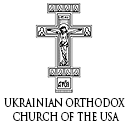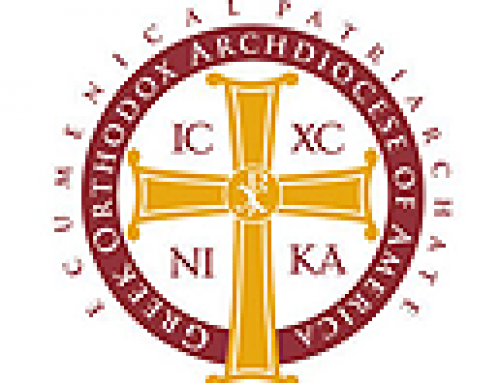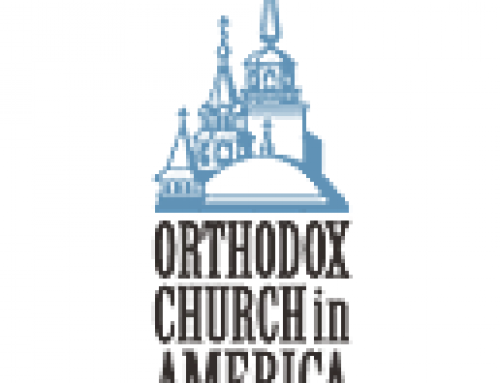This post was originally published on this site
Heading back to the entry door, they paused at the Stone of Anointing, which marks the location where the Lord’s Body was anointed for burial and marveled at the large mosaic icon upon the wall beyond. Heading up the curved stone well-worn steps they found themselves in the Chapel on Golgotha. With the depiction of Christ crucified before them, they approached reverently and kneeled before the altar, reaching down to touch the spot where the Cross once stood. To the right of the altar behind a glass partition is visible the stone surface of the Golgotha – with a deep fissure where the stone cracked during the earthquake which occurred when Christ died upon the Cross. To the left of this stone is a tiny Roman Catholic chapel where the Lord was nailed to the Cross.
Heading back downstairs, the faithful attended the reading of the Holy Gospel before continuing the sojourn around the Church. It was surreal gazing upon these holy sites with the Divine Liturgy being served, and the sweet aroma of the incense swirling around in the dim candlelight making the entire scene seem otherworldly.
There are 30 chapels peppered around the large Church of the Resurrection, divided between the Greek Orthodox Church, Roman Catholics, and the Armenian Orthodox Church. Orthodox monastics could be found in the tiniest nooks in the facade of the Church – kneeling, praying, sitting in contemplation, guarding, dozing, and being a constant presence of faith at the Center of the Earth.
Leaving behind the crowd, some of the pilgrims headed down an old marble set of steps, finding themselves in a beautiful church below ground. The underground chapel was magnificent and unexpected. Here one such Coptic monk sat on the floor in a corner praying quietly, oblivious to the people milling about him. This was the 12th-century Armenian church of St. Helena, constructed during the Kingdom of Jerusalem. There are two apses in the church, one dedicated to Saint Helena and one to the penitent thief on the cross. The chapel is modestly adorned in memory of Saint Helena’s simplicity.
There were more steps leading deeper underground. Taking these, they found themselves in the Chapel of the Discovery of the Cross, where St. Helena uncovered and identified the Cross of Christ. Along the right was a glass wall, behind which was clearly visible the stone of Golgotha which was directly above them, and the continued fissure in the stone from above, leading all the way down to this point.
Returning to the main floor the pilgrims made their way around, stopping at various chapels to pray, and contemplate life. They paused at the Orthodox Chapel of Jesus’ Prison, where it is said the Lord was held prior to His Crucifixion.
Behind the tomb of Jesus, on the western side of the Holy Sepulchre Rotunda walls, they happened upon the Jacobite (Syrian Orthodox) chapel. The chapel is located in the 4th Century Constantine church walls. On the southern side of the chapel are typical first century Jewish tombs. According to Christian tradition, these are of Joseph of Arimathea and Nikodemus who took down and buried the body of Christ.
Well after 4 a.m. the pilgrims once again returned to the crowd located in the center of the Church and attended the Divine Liturgy. Having communed, they quickly stepped aside to allow others to approach one of numerous chalices being offered to the faithful.
Tired and hot, they slowly made their way to the cool air outside and awaited the rest of their party in the courtyard in front of the church. Here they once again looked upon the ladder on the second story, but most of their attention went to the pillar to the left of the doorway.
The keys to the main entrance of the Church of the Holy Sepulchre are entrusted to two of the Muslim families since Saladin era. It is a reminder of the long-term Muslim governance of Jerusalem, that the responsibility to open and lock the door of the Holy Sepulchre, Christianity’s holiest place, rests in the hands of Muslims.
During the Pascha of 1549 AD, the Armenians were successful in bribing the Turkish Administrator to issue an order forbidding the Greek Orthodox Patriarch Sophronios IV from entering the Church to perform the ceremony of the Holy Light. The guards closed the Holy Door and Patriarch Sophronios IV, accompanied by men of the cloth and the faithful, stayed outside, praying. That year, the Holy Light did not shine within the holy Aedicule, or anywhere within the Church. Instead, it burst through the Pillar which to this day remains cracked and blackened. To everyone’s great surprise, the candles held by the Orthodox Patriarch then lit up. Sophronios went on to share the Light with the Orthodox faithful in the courtyard, whereas the Armenian Patriarch left the scene in shame. This miraculous event was witnessed by Emir Tounom, a guard at the Holy Door. According to one tradition, Tounom became a Christian, and was killed by the Turks in order to silence the event. A different tradition relates that, upon witnessing the miracle, Tounom exclaimed “Behold the true faith” – and for it he was burnt alive by the Turks. Today his relics are kept in the Monastery of the Great Panaghia. When the Sultan was informed of the miracle, he issued a decree recognizing the Orthodox Patriarch’s exclusive right to receive the Holy Light.
Gazing upon the darkened and cracked pillar by the door they could see many tiny slips of paper upon which the faithful had written prayers, folded, and squeezed into the cracks. Further up the column were countless etchings of Crusader Crosses, etched by pilgrims over the previous centuries.
As His Eminence reappeared, flanked by the clergy from the UOC of the USA, the group gathered in the dark courtyard and having experienced such a soul stirring morning, moved by the Holy Spirit they sang “Christ is Risen”. Their soft voices carried upon the cool air and traveled beyond the courtyard, through the back alleys of Jerusalem, through the opened windows, and down the byways. Indeed He is Risen!



